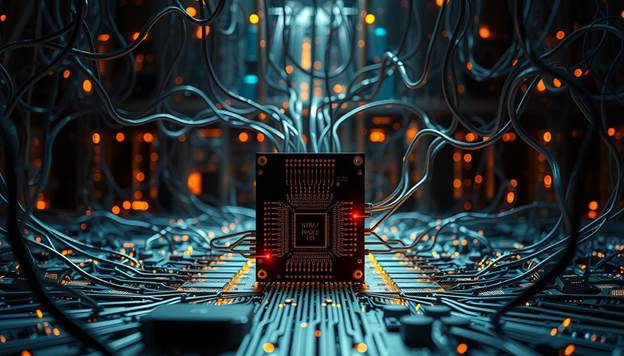What Is Artificial Intelligence and Why Does It Matter Today?
Imagine a world where machines can think and learn like humans. This is not from a science fiction movie; it is real with artificial intelligence (AI) today.

AI is changing how we live and work, making it key in our daily lives. It ranges from virtual assistants to complex algorithms. AI is transforming industries and opening new opportunities.
It is important to understand AI in today’s tech world. It can lead to innovation, better efficiency, and solving complex problems.
Key Takeaways
- AI is changing the way we live and work.
- It has the potential to drive innovation and improve efficiency.
- Understanding AI is crucial in today’s technology-driven world.
- AI is being used in various industries, from healthcare to finance.
- The future of AI holds much promise and potential.
Understanding Artificial Intelligence (AI): The Basics
Exploring technology, we find Artificial Intelligence (AI) is key. AI spans many fields, from computer science to engineering. It is changing how we use technology.
The Definition of AI in Simple Terms
So, what is AI? Simply put, AI means making computers do things that humans do, like seeing, hearing, and deciding. These computers work on their own, using data and rules to make choices.
AI is like a range, from simple rules to complex learning systems. The main thing about AI is it can look at data, find patterns, and predict or decide based on that.

A Brief History of AI Development
The idea of AI has been around for years, but big steps have been made lately. The term “Artificial Intelligence” was first used in 1956 by John McCarthy, a computer scientist.
AI’s growth has seen important moments, like:
- The first AI program, Logical Theorist, was made in 1956.
- Expert systems came in the 1970s and 1980s, copying human choices.
- Machine learning started in the 1990s and 2000s, letting AI learn from data.
Now, AI is growing fast, used in healthcare, finance, transport, and education. As AI gets better, it will change many parts of our lives.
How AI Actually Works
Exploring AI technology reveals its complex workings. It enables machines to do tasks that need human smarts.
AI’s core strength is learning and adapting. This is thanks to machine learning, a key part of AI.
Machine Learning Explained Simply
Machine learning is a part of AI that lets computers learn from data. They do not need to be programmed for it. They learn by training on big datasets.
For example, in image recognition, AI models learn from lots of images. They get better at telling objects apart over time.
Neural Networks and Deep Learning
Neural networks are key in deep learning. They are inspired by the brain. These networks have layers of nodes that process information.
Deep learning has led to big leaps in AI. It is improved speech recognition, natural language processing, and image recognition. The networks can spot patterns that simpler models cannot.

The Role of Data in AI Systems
Data is vital for AI. The quality and amount of data affects how well AI models work. AI uses data to learn and get better.
The table below shows the types of data used in AI and their uses:
| Type of Data | Application in AI | Example |
| Structured Data | Used in predictive modeling and decision-making processes. | Customer databases, financial records. |
| Unstructured Data | Utilized in natural language processing and image recognition. | Text documents, social media posts, images. |
| Semi-structured Data | Applied in data integration and analysis tasks. | XML files, JSON data. |
In summary, AI technology thrives on processing and learning from data. As AI grows, knowing how it works is key to using it fully.
The Different Types of AI You Should Know
AI is growing fast, and it is key to know its different kinds. AI types are based on what they can do and how they learn. This helps us understand their roles in our lives.
Narrow AI vs. General AI
AI falls into two main groups: Narrow AI and General AI. Narrow AI does one thing well, like recognizing faces or translating languages. It works within a set range and is what we see most today.
General AI is a dream AI that can do anything a human can. It is still being worked on and is a big goal for AI research.

Learning Methods in AI Systems
AI learns in many ways, which is key to its growth. The main methods are supervised, unsupervised, and reinforcement learning.
1. Supervised Learning
Supervised learning uses labeled data to train AI. It teaches us to predict by looking at examples. It is used in things like recognizing images and understanding speech.
2. Unsupervised Learning
Unsupervised learning lets AI find patterns in data without labels. It is used for finding hidden data structures and grouping similar items.
3. Reinforcement Learning
Reinforcement learning lets AI learn by trying things and getting feedback. It is great for teaching AI to make decisions, like in games and robotics.
Andrew Ng says, “AI is like electricity, changing many fields.”
“AI is the new electricity. Just as electricity transforms numerous industries, AI will do the same.”
This change is thanks to the many AI types and how they learn. Together, they are changing our world in big ways.
Real-World Applications of AI in Your Daily Life
Artificial intelligence surrounds us every day. It makes our lives easier and more fun. From waking up to bedtime, AI works to improve our daily routines.
AI in Smartphones and Personal Devices
AI has a big impact on our phones and devices. Virtual assistants like Siri and Google Assistant help us a lot. They do tasks, give info, and control our smart homes.
Key Features of AI in Smartphones:
- Personalized recommendations based on usage patterns.
- Enhanced security through facial recognition and fingerprint scanning
- Improved camera capabilities with AI-driven image processing

AI in Healthcare and Medicine
AI is changing healthcare a lot. It makes diagnoses more accurate and helps doctors work better. AI looks at lots of medical data to find patterns and predict patient results.
“AI has the potential to transform healthcare by providing more accurate diagnoses, reducing costs, and improving patient outcomes.”
Dr. John Smith, AI Researcher
| Application | Description | Benefit |
| Medical Imaging Analysis | AI analyzes medical images to detect abnormalities | Early detection of diseases like cancer |
| Personalized Medicine | AI tailors’ treatment plans based on patient data | More effective treatment outcomes |
| Clinical Decision Support | AI provides healthcare professionals with data-driven insights | Informed decision-making |
AI in Transportation and Smart Cities
AI is changing how we travel and live in cities. It makes traffic better, keeps us safe, and makes travel smoother. In smart cities, AI works with the city’s systems to make them better.
Examples of AI in Transportation:
- Predictive maintenance of public transport vehicles
- AI-driven traffic management systems
- Autonomous vehicles for public and private transport
AI in Entertainment and Content Creation
The entertainment world uses AI to make better content and personalize what we see. AI looks at what we like to suggest shows and music. It even creates art and music on its own.
AI Applications in Entertainment:
- Content recommendation systems on streaming platforms
- AI-generated music and art
- Virtual reality experiences enhanced by AI.
How to Start Using AI Tools Today
Starting to use AI in your daily life is easy and rewarding. There are many AI tools out there, making it simple to get started. Whether you want to boost your productivity, make tasks easier, or explore new tech, AI has something for you.
Setting Up Personal AI Assistants
One easy way to use AI is by setting up a personal AI assistant. These assistants can manage your schedule, give you information, and control smart devices.
Getting Started with Siri, Alexa, and Google Assistant
To start with, pick from popular AI assistants like Siri, Alexa, or Google Assistant. Each has special features and works with different devices.
- Siri: Integrated into Apple devices, Siri offers a seamless experience for iPhone, iPad, and Mac users.
- Alexa: Amazon’s Alexa is known for its compatibility with a wide range of smart home devices, making it a great choice for home automation.
- Google Assistant: Google Assistant is renowned for its ability to understand complex commands and provide detailed information, making it ideal for those who rely on Google services.
Customizing Your AI Assistant for Better Results
Once you have picked an AI assistant, customizing it can make your experience better. This includes setting up routines, changing wake words, and linking them with other services you use.
For example, you can create a morning routine that tells you the weather, reads out your schedule, and news updates. Each assistant has different customization options, so it is important to explore their settings to get the most out of them.
AI-Powered Apps Worth Trying
There are also many AI-powered apps that can improve your productivity, creativity, and fun. Some examples include:
- Virtual note-taking apps that use AI to organize your notes and even predict what you might need to jot down next.
- AI-driven photography apps that can edit your photos automatically, applying professional-grade adjustments with a single tap.
- Language learning apps that utilize AI to provide personalized learning paths and real-time feedback on your pronunciation.
Tips for Effective AI Interactions
To get the most out of AI tools, it is important to know how to interact with them well. Here are some tips:
Using Clear Commands and Questions
AI tools are designed to understand natural language but being clear and specific with your commands or questions gives better results. For example, instead of asking, “What’s the weather?” you could ask, “What’s the weather forecast for New York tomorrow?”
Providing Feedback to Improve AI Performance
Many AI systems learn from the interactions they have with users. Giving feedback, whether it is correcting a misunderstanding or rating the response, helps improve their performance over time.
By following these guidelines and exploring the various AI tools available, you can start using artificial intelligence to make your life easier and more productive.
The Future of AI: Opportunities and Challenges
The fast growth of AI technology brings both exciting chances and tough challenges. It is key to grasp the full scope of what is AI and its wide-ranging effects on our lives.
New AI technologies are set to change many fields, like healthcare and finance. For example, machine learning and neural networks are leading to better data analysis and choices.
Conclusion: Embracing AI in a Changing World
Artificial Intelligence is changing our lives in big ways. It is making our smartphones smarter, improving healthcare, and changing how we travel. AI is becoming a big part of our world.
AI is not just a trend; it is a big change. It makes our lives easier, more efficient, and connected. By using AI, we can find new chances, work better, and live better.
As AI keeps getting better, we need to stay up to date. This way, we can use AI to make our future better. We can make sure technology helps us, not hinders us.
FAQ
What is Artificial Intelligence (AI)?
Artificial Intelligence is when computers do things that humans usually do. This includes learning, solving problems, and making decisions. It lets machines think and act like us.
How does AI work?
AI uses special algorithms and lots of data to learn and decide. Machine learning is a part of AI that helps systems get better at tasks over time.
What are the different types of AI?
There are many types of AI. Narrow AI does one thing well, while General AI can do lots of things. General AI is still just an idea, but it is exciting.
How is AI used in daily life?
AI is everywhere in our daily lives. It is in virtual assistants like Siri and Alexa, and in apps that help us with health and fun. It makes our lives easier and more fun.
What is the role of data in AI systems?
Data is key for AI. It helps train and improve AI models. Good data lets AI systems learn and make smart choices.
How can I start using AI tools?
To use AI tools, start with personal assistants like Siri or Google Assistant. Try AI apps that fit your needs. Giving clear commands helps AI tools get better.
What are the benefits and challenges of AI?
AI makes things more efficient and accurate. It helps us make better choices. But AI also has downsides like losing jobs and facing bias. We must think about these issues.
What is the future of AI?
The future of AI looks bright with new tech and learning. As AI grows, it will change many parts of our lives. We should be excited and ready for these changes.





